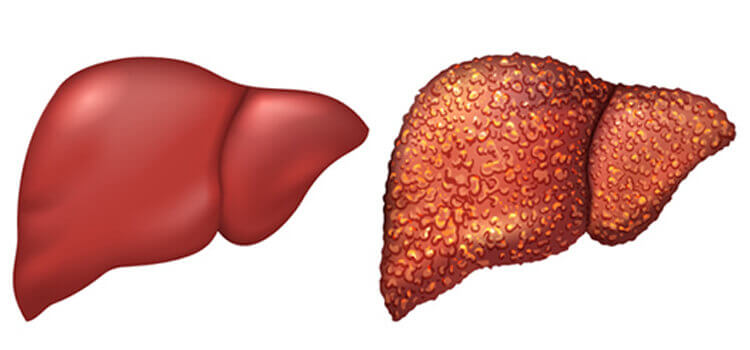
LIVER CIRRHOSIS
Cirrhosis is a disease of the liver which involves damage to liver cells & irreversible scarring of the liver. Scarring occurs as a result of long term exposure to toxins such as alcohol or viral infections
Liver is situated on the upper right corner of the abdomen just below the rib cage. Its main functions include the following:
- Producing bile to help the body absorb vitamins and nutrients
- Storing Sugar & nutrients
- Purifying blood by removing toxins
- Creating blood clotting proteins
- Nausea
- Jaundice
Liver has the capacity to repair & regenerate itself. But long term exposure to toxins & and excessive scar build up can lead to irreversible damage
What are the Symptoms?
In most cases, there may be no symptoms until advanced stages. Following are some of the signs & symptoms of Cirrhosis:
- Tiredness & Fatigue
- Loss of appetite
- Nausea
- Itchiness
- Unintended weight loss
- Swelling in feet & ankles
- Jaundice
- Fluid build up in the abdomen
- Absence of periods in women
- Breast enlargement, loss of sex drive in men
- Slurred speech & drowsiness
What are the Causes?
Some of the common causes of liver cirrhosis are:
- Excessive alcohol consumption for long periods of time
- Hepatitis B, C & D
- Cystic fibrosis
- Non Alcoholic Fatty Liver disease
- Hemochromatosis or excessive iron accumulation in the body
- Autoimmune hepatitis
- Primary Biliary Cirrhosis
- Primary Sclerosing Cholangitis
- Infections
- Certain types of medications
What are the Risk Factors?
- Excessive consumption of alcohol
- Obesity can lead to Non alcoholic fatty liver disease & nonalcoholic steatohepatitis which can lead to cirrhosis of the liver
- Chronic hepatitis
Are there any complications?
If left untreated, cirrhosis can lead to severe complications such as:
- Portal Hypertension
- Swelling in the legs
- Fluid accumulation in the abdomen
- Enlargement of spleen
- Bacterial infections
- Jaundice
- Toxin build up in the brain
- Jaundice
- Liver Cancer
How is it diagnosed?
Diagnosis of Liver Cirrhosis may involve the following tests:
- Blood tests to check for signs of liver & kidney malfunction
- Magnetic Resonance Elastography detects hardening of the liver.
- MRI
- CT Scan
- Ultrasound
- Liver Biopsy
How is it treated?
The main aim of the treatment for cirrhosis is to slow down scarring of the liver tissue, ease symptoms and prevent complications. Treatment options include:
- Weight Loss - In case of patients with Cirrhosis resulting from Non alcoholic liver disease, weight loss & control of blood sugar levels can help improve their symptoms
- Reducing or stopping alcohol consumption: It is important for patients with cirrhosis to completely stop consuming alcohol, as even small amounts can be toxic for the live
- Medications to stop further damage to the liver caused by Hepatitis B or C infections
- Medications to stop progression of the disease
The doctor may also recommend a diet low in sodium to control edema in legs & feet. Antibiotics & vaccinations may also be suggested to treat other infections
How can it be prevented?
Simple lifestyle modifications can make a huge difference and cut down your risk of liver cirrhosis manifold.
- Eat a lot of fruits & vegetables, whole grains & lean sources of protein.
- Have an exercise routine and keep your weight in check
- Do not consume alcohol
- Avoid using shared needles to cut down on your risk of Hepatitis B & C infections




